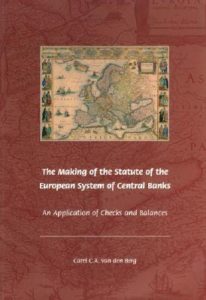Carel C.A. van den Berg – The Making Of The Statute Of The European System Of Central Banks
No comments yet You can download the complete book (PDF-file) here: CCAvdBerg – MakingofStatute
You can download the complete book (PDF-file) here: CCAvdBerg – MakingofStatute
Dutch University Press, Amsterdam, 2004, 2005 ISBN 90 3169 292 7 – This book is the commercial edition of the dissertation defended and approved at the Faculty of Economics and Business Administration of the Vrije Universiteit of Amsterdam on 29 October 2004 . Thesis printed by Thela Thesis – ISBN 90 5170 997 8 (2004).
Zur Thematik
The creation of the Economic and Monetary Union (EMU) is one of the most profound steps in the monetary history of Europe, which has significance not only for professionals, politicians and academics, but also for everyday life. Among the accomplishments that stand out are the establishment of a federally structured European System of Central Banks (ESCB)[i]and the introduction of a single currency. The opinions and decisions of the European Central Bank (ECB)[ii] are almost daily topics for the national newspapers, discussions on its accountability (or perceived lack thereof) are recurrent topics in the European Parliament and political and academic circles. In short, the ECB has become a reality for almost everyone within a couple of years since its establishment. Technically it has been successful: the transition from national currencies to a single currency, the euro, has been a remarkably smooth process despite the gigantic scale of the operation. Though it is too early to evaluate how effective the ECB is in implementing its mandate, for the Monetary Union as a whole inflation rates are lower than they were during a large part of the nineties.
The legal underpinnings of the System and its independence have been extensively studied, see e.g. Stadler (1996), Smits (1997) and also Endler (1998). Also, from a political angle, the degree in which the negotiations leading up to the signing of the so-called Treaty of Maastricht in February 1992 could be characterized as a success for the German or for the French negotiators has been analyzed, e.g. by Viebig (1999) and Dyson/Featherstone (1999). In many respects these authors have concluded that it was a German success. However, the ESCB is not a copy of an existing central bank, not even the Bundesbank. It has been established on the basis of a unique Statute.[iii] This Statute will guide the ECB, also in the future. But like many texts, the Statute is sometimes ambiguous. For a right interpretation of the texts it is important to know their genesis. Sometimes wording was copied from existing other texts, sometimes texts are a delicate compromise, sometimes texts have a difficult technical history.
What distinguishes this study from these other studies is that these studies analyzed the ESCB from only one perspective, i.e. either from a legal, political or economic point of view. This study aims to show how political, economic and institutional considerations were combined and have found their way into the (legal) wording of the ESCB Statute. To this end I focus on each article, describing the economic rationale behind it as well as its genesis, systematically using historical sources which until now have not been used for these purposes. The perspective I take in order to interpret, analyse and assess the Statute of the ESCB is that of checks and balances. We will identify and study the ‘checks and balances’ which have been introduced in the Statute of the ESCB. ‘Checks and balances’ are an important characteristic of any federally designed system. They are part of the ‘rules of the game’, which have to be taken into account by the components of the system, which rules should ensure the system’s stability and effectiveness. For instance, ‘checks and balances’ prevent the possibility of ‘winner takes all’, because this would mean the end of the federal character. A clear normative framework for checks and balances for federal central bank systems is not available, though there are general notions which any workable system of checks and balances has to accord with. Therefore, we will develop a framework to describe the checks and balances in central bank systems.
The concept of checks and counterchecks also played a role when the American central bank system (the Federal Reserve System, FRS) was designed. A nice description can be found in P.M. Warburg in his book ‘The Federal Reserve System, Its Origins and Growth’ (1930), p. 166: ‘The position of the Reserve Board, as designed in the Act [of 1913], was bound to prove exasperatingly difficult and trying. The office was burdened with the handicap, commonly imposed upon so many branches of administration in a democracy, of a system of checks and counter-checks – a paralyzing system which gives powers with one hand and takes them away with the other. […] Success or failure in such cases generally depends on the wisdom with which the balancing of the checks and counter-checks in a legislative act is handled, and on the intelligence with which, later on, the act is administered.’ And ibidem p. 170: ‘[….] many attempts were made to find a satisfactory answer to the tantalizing puzzle of how to safeguard the autonomy of the reserve banks while giving, at the same time, adequate coordinating and directing powers to the Reserve Board.’ From our study it appears that these considerations were still relevant for the conception of the European central bank.
You May Also Like
Comments
Leave a Reply









